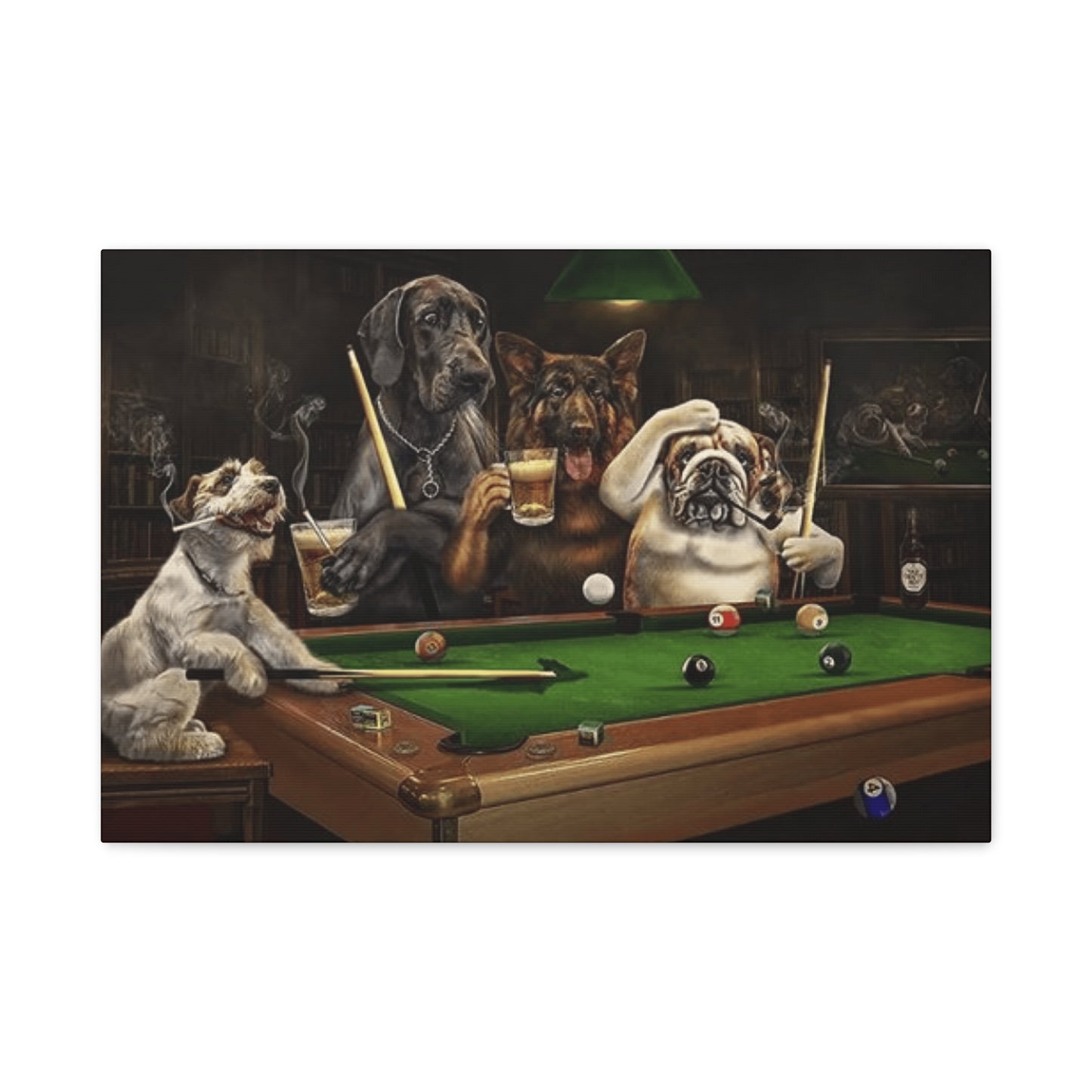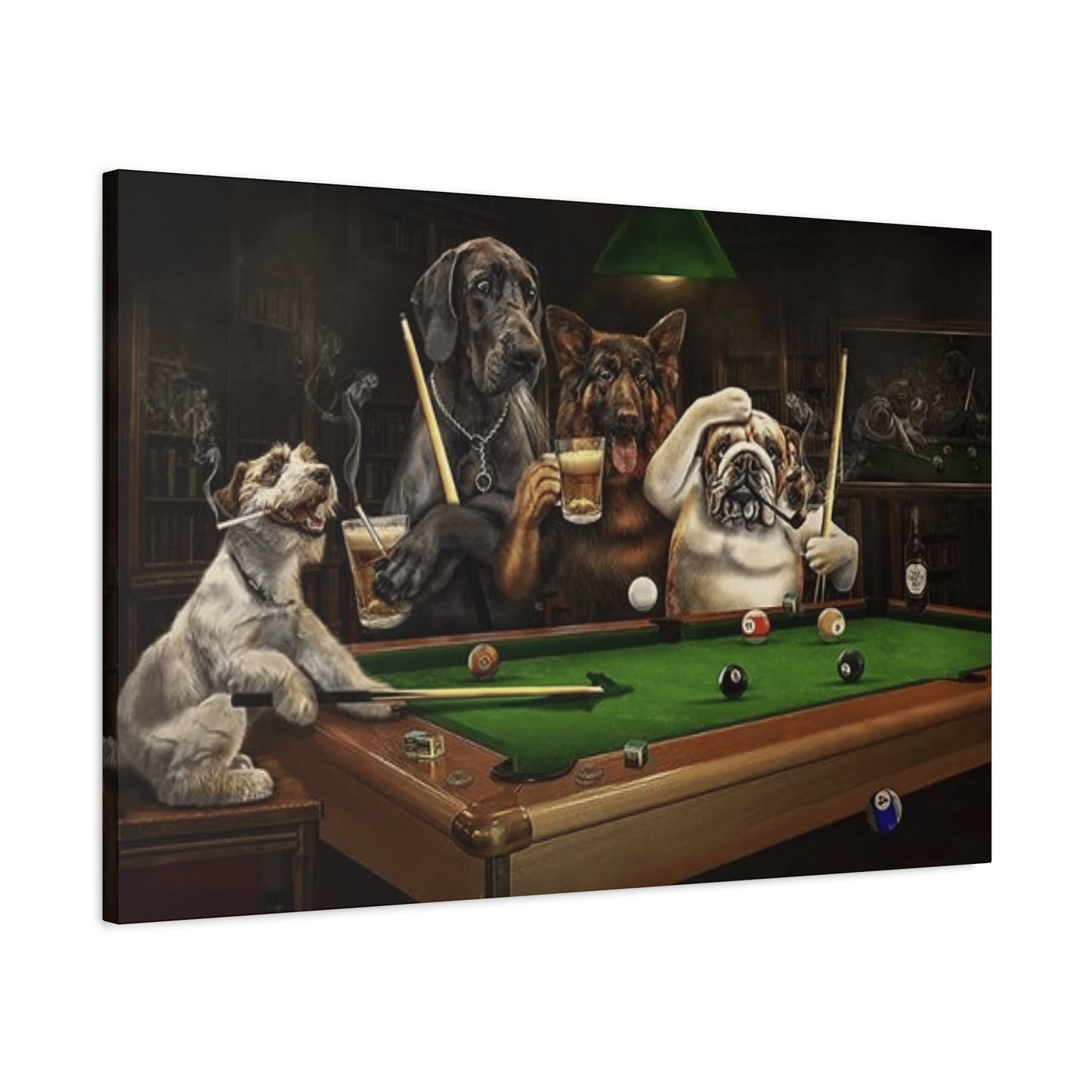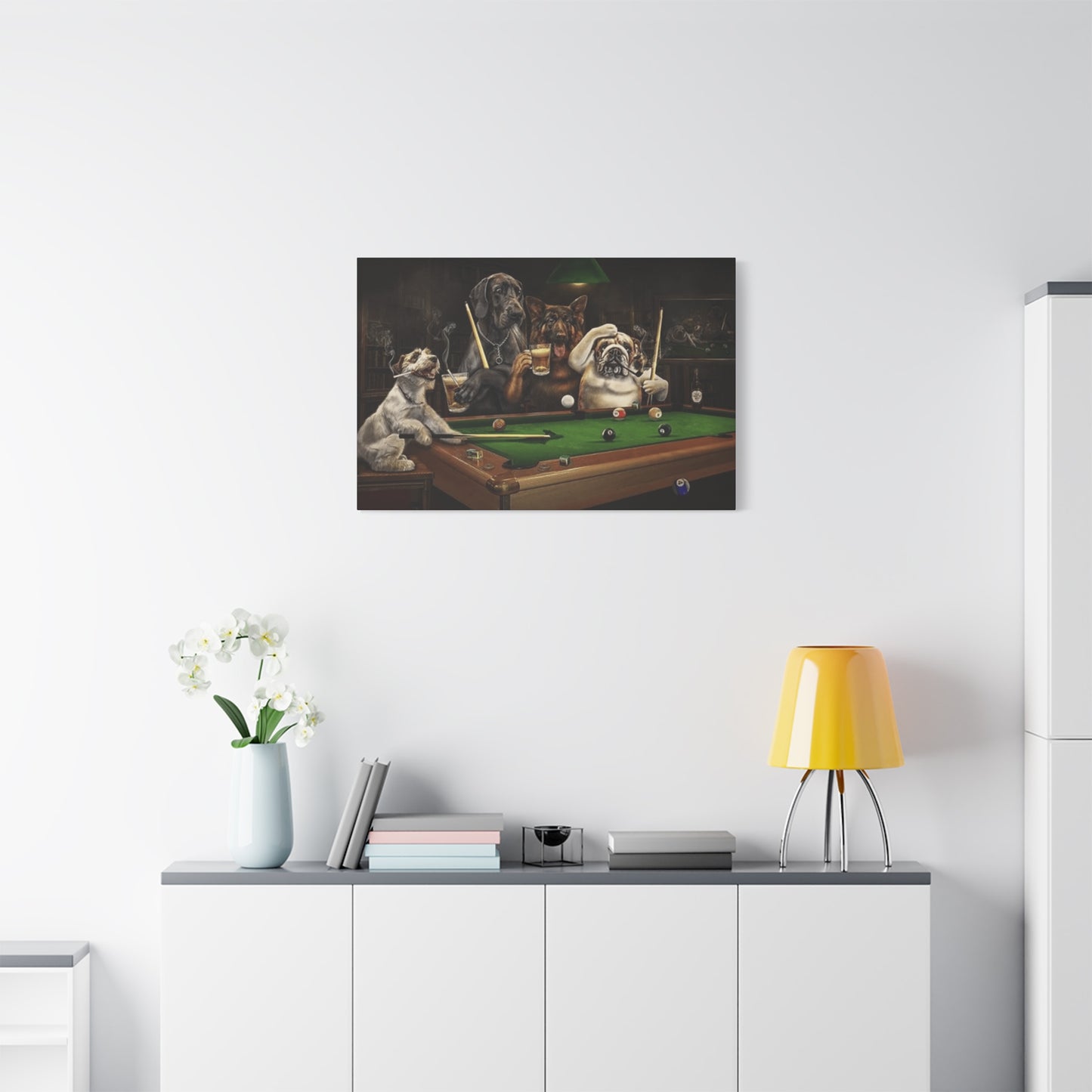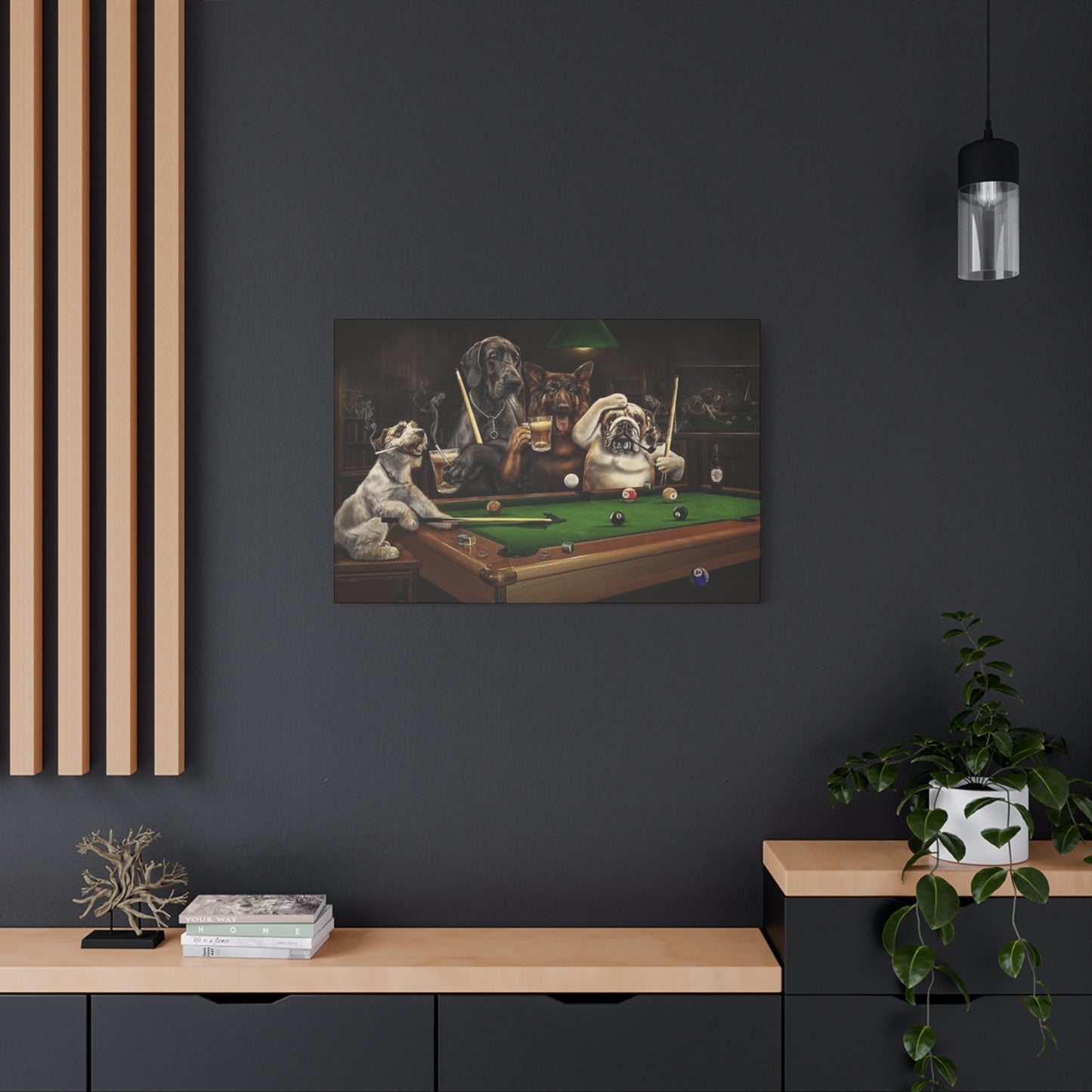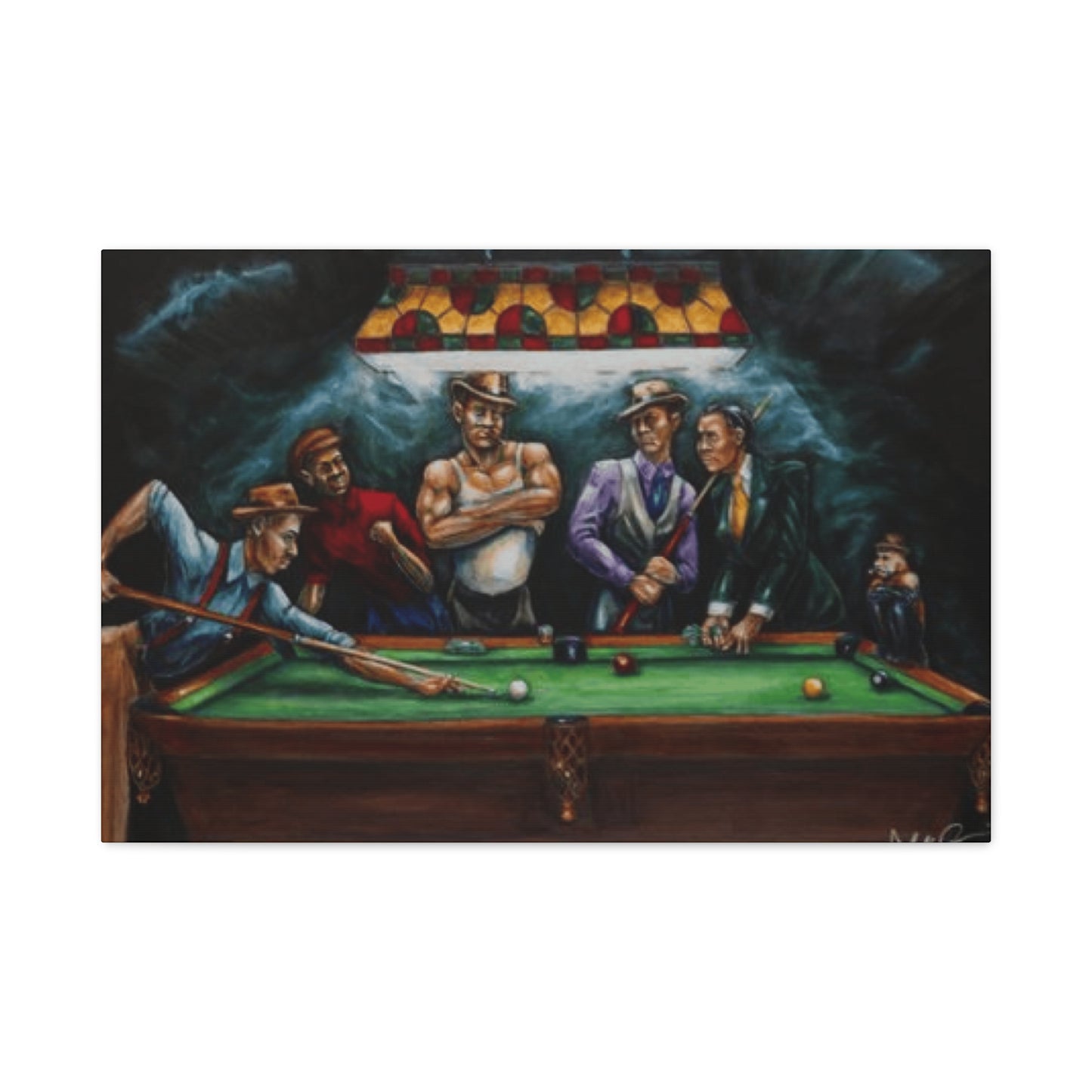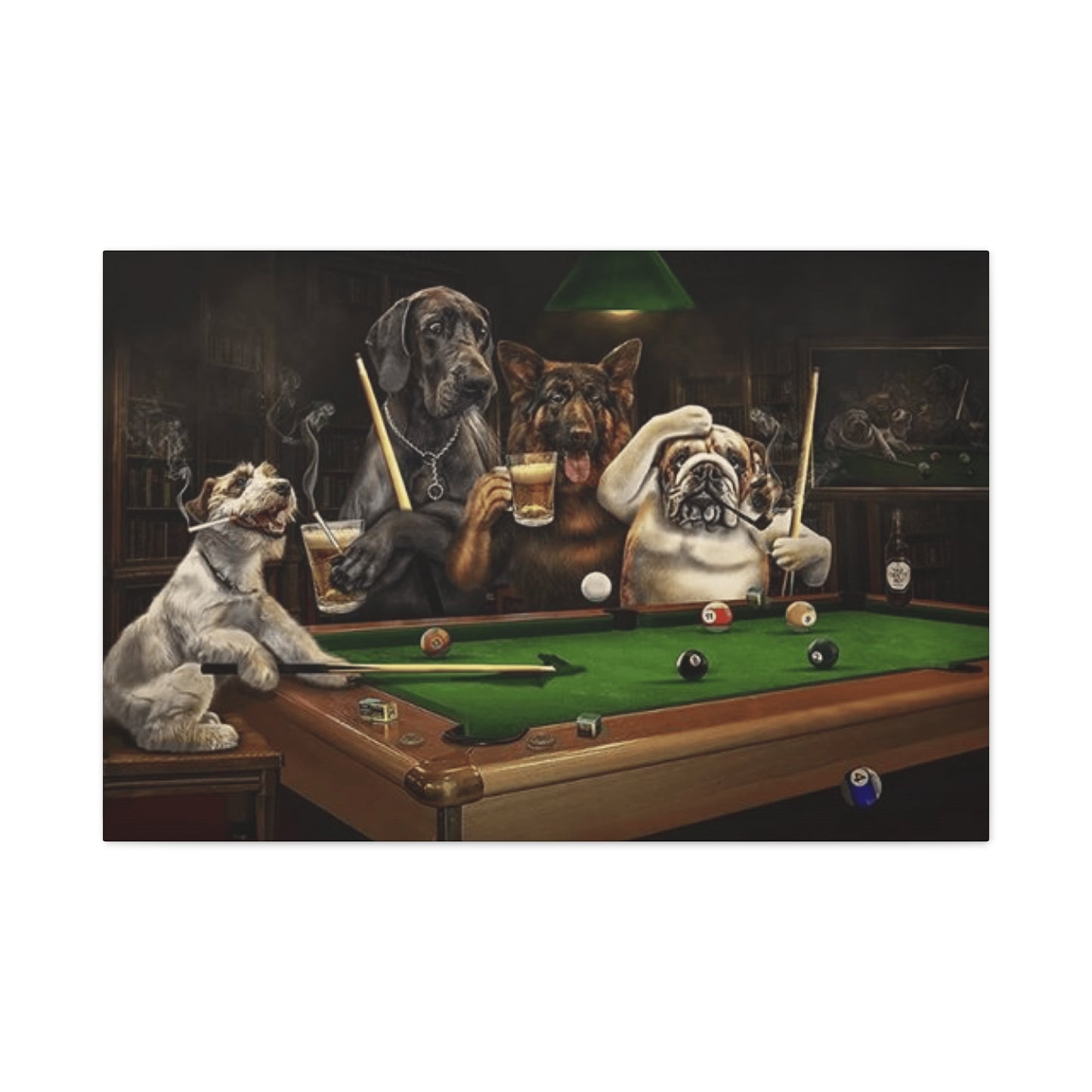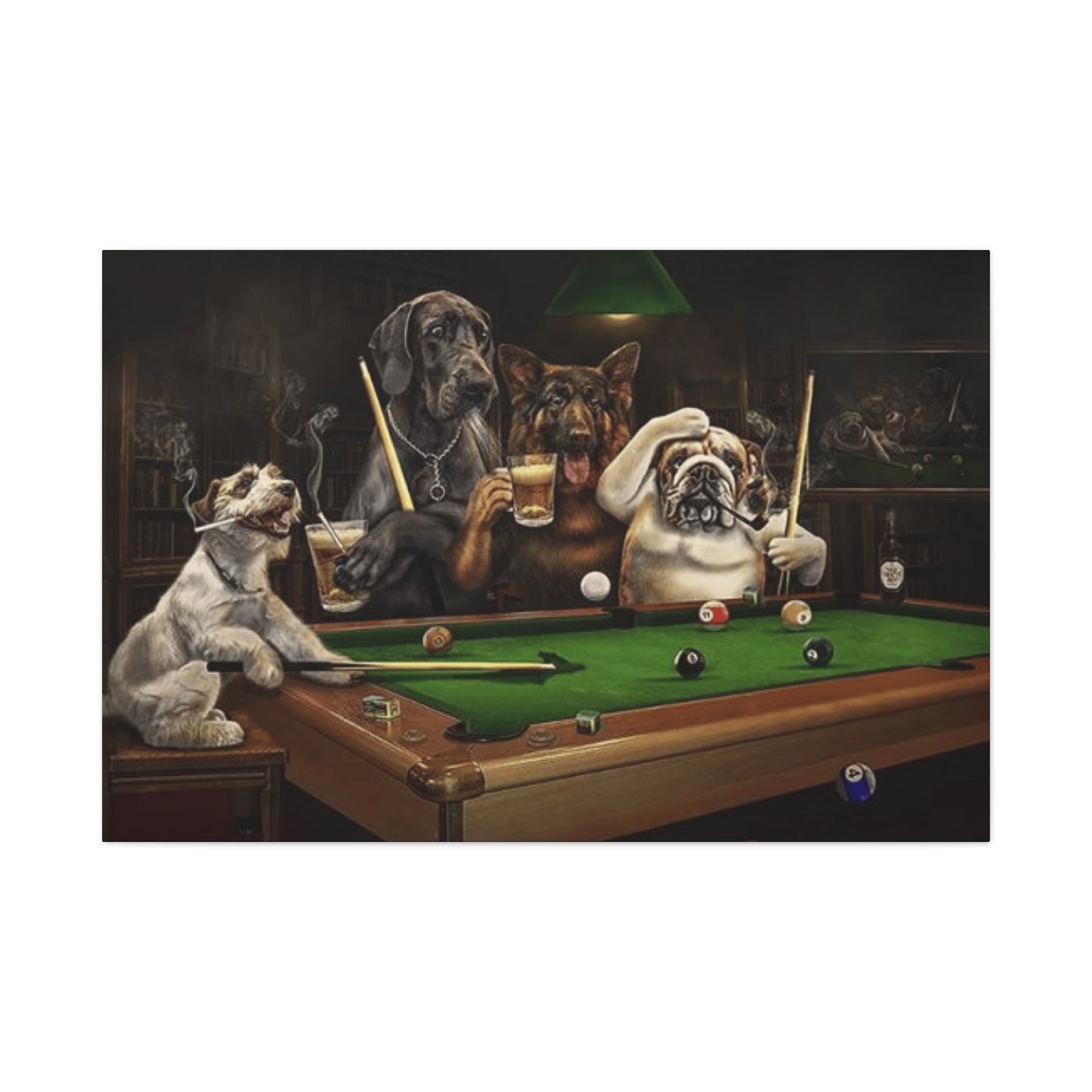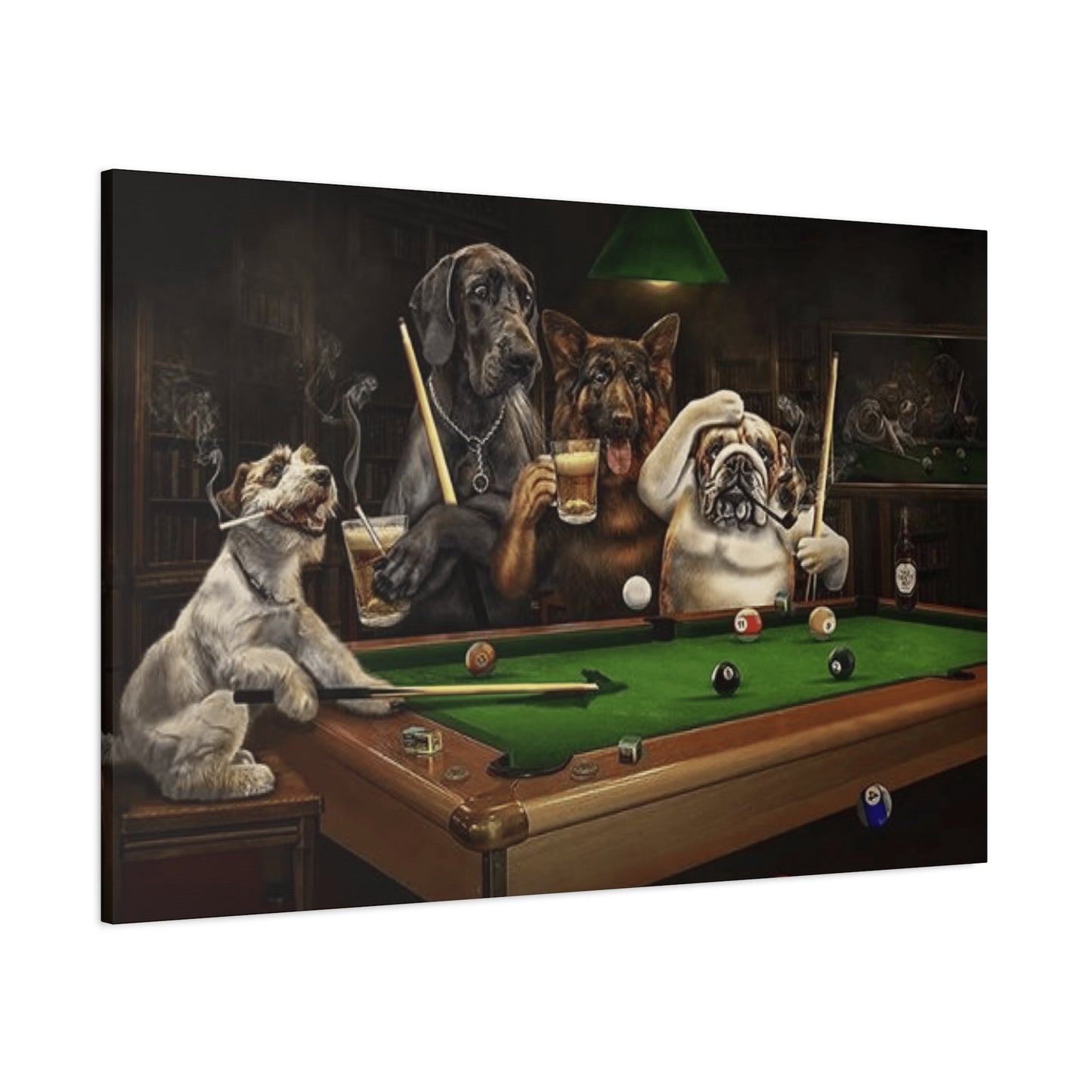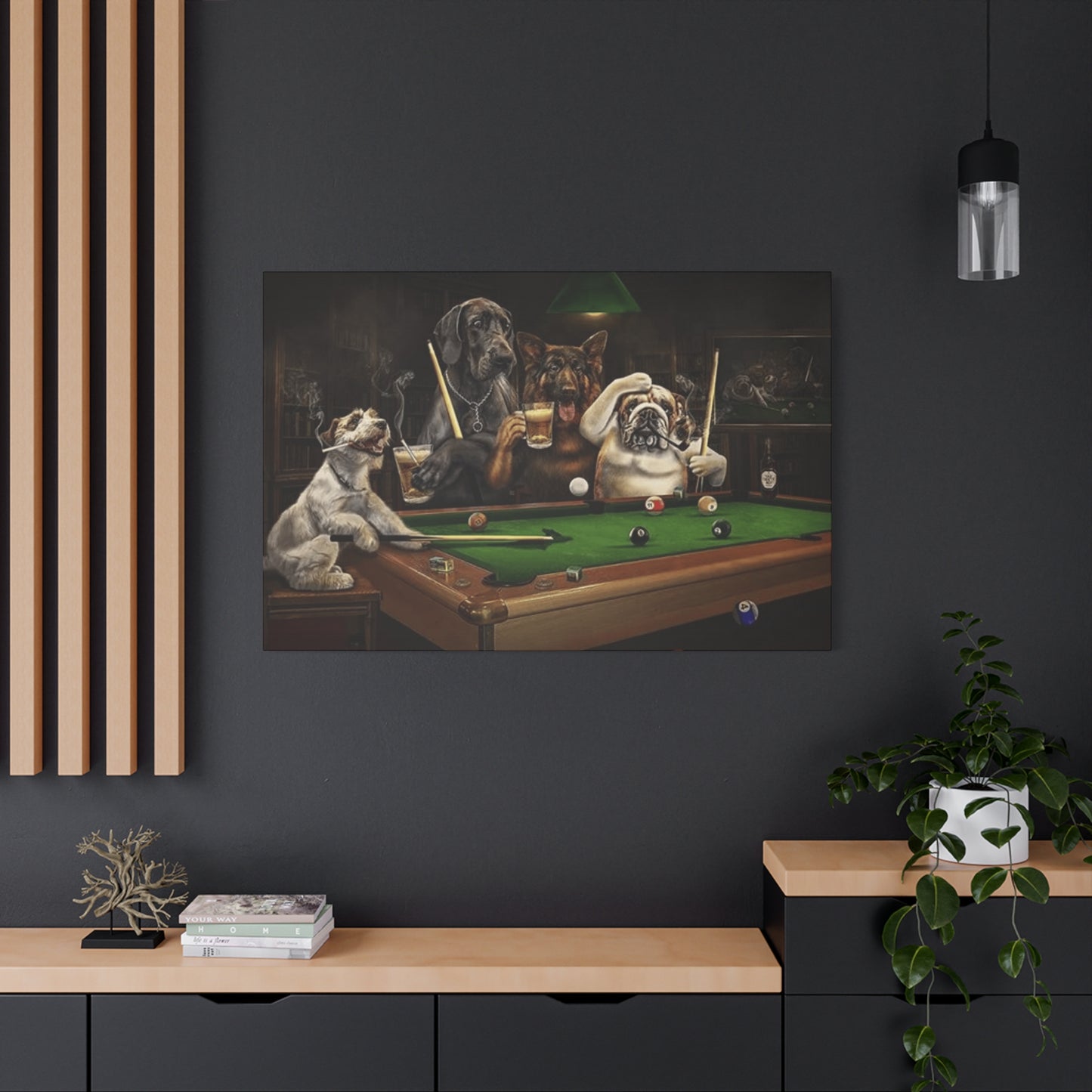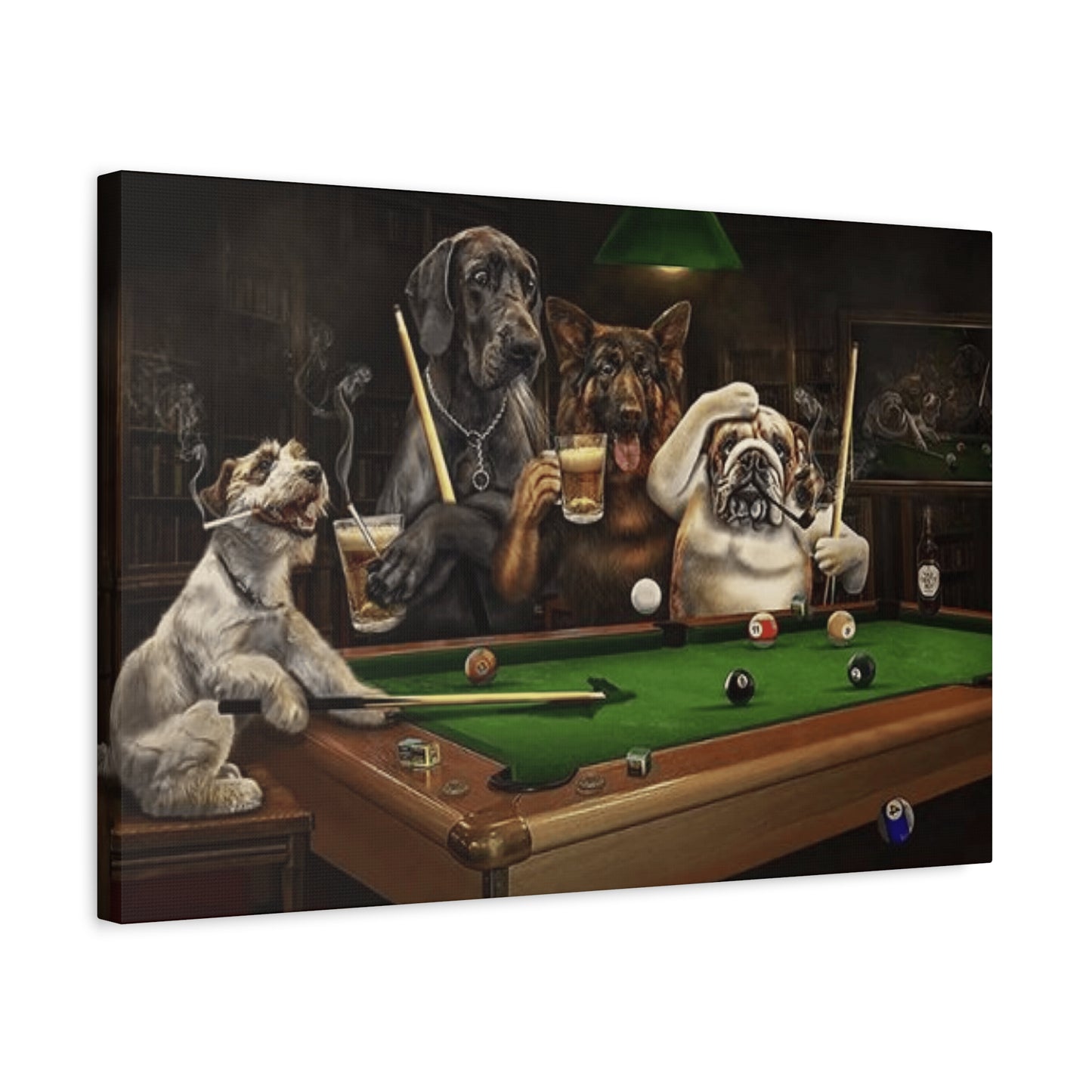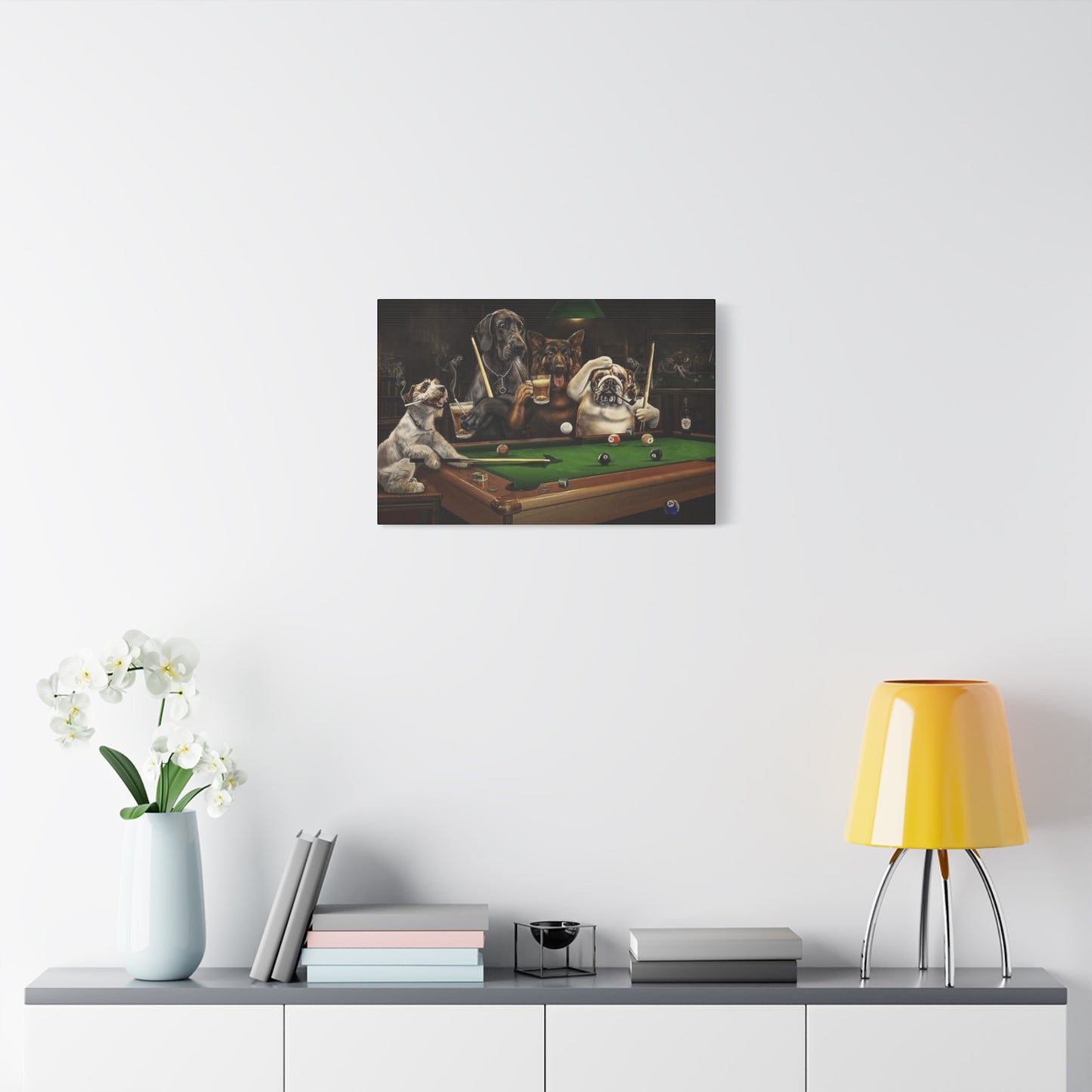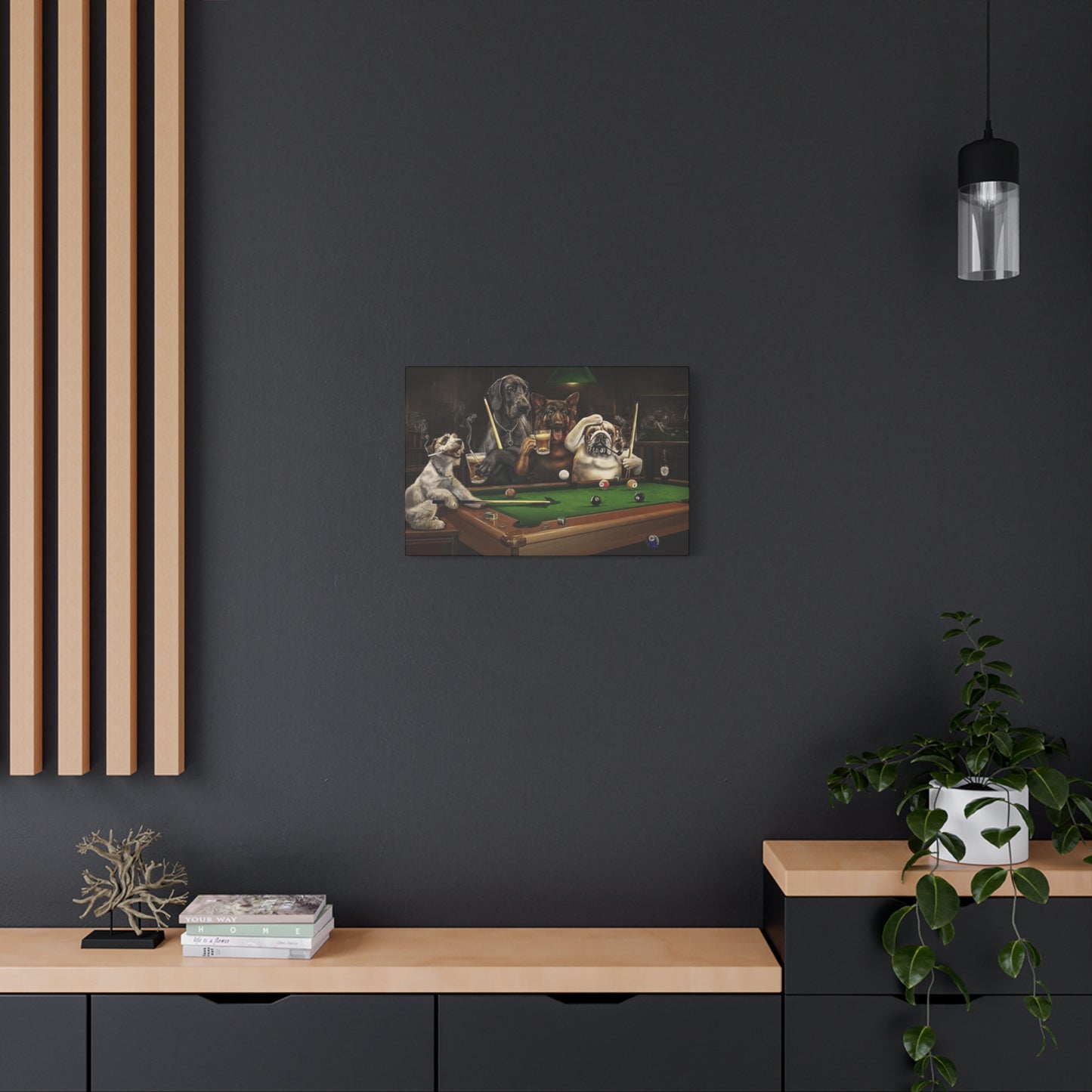Canine Snooker Wall Art: Bringing Playful Pet Personality to Your Home
The world of home decoration has witnessed numerous trends come and go, but few have captured hearts quite like the whimsical charm of dogs playing snooker wall art. This delightful artistic theme combines our collective love for canine companions with the sophisticated appeal of billiards, creating conversation pieces that instantly transform any room into a more engaging and personality-filled environment. The popularity of such artwork stems from its ability to inject humor, warmth, and character into homes while maintaining an element of classical sophistication that appeals to diverse tastes and age groups.
These artistic creations go beyond simple decoration; they represent a cultural phenomenon that reflects our deep connection with our four-legged friends and our appreciation for leisure activities. The concept draws inspiration from various sources, including classic paintings, pop culture references, and our own experiences watching dogs exhibit surprisingly human-like behaviors. When we observe our pets displaying intelligence, strategy, or social interaction, we can easily imagine them engaged in activities traditionally reserved for humans, making dog snooker wall art both relatable and entertaining.
The versatility of this artwork style makes it suitable for various home environments, from casual family rooms to more formal game areas. Whether rendered in oil paintings, digital prints, vintage-style posters, or modern canvas works, these pieces serve as focal points that encourage conversation and bring smiles to viewers' faces. The artistic interpretations range from highly realistic portrayals to cartoon-like representations, ensuring that there's a style to match every homeowner's aesthetic preferences and existing decor themes.
Enhancing Game Areas with Canine-Themed Billiards Artwork
Game rooms and entertainment areas provide the perfect backdrop for dog-themed billiards wall art, as these environments are naturally designed for relaxation, fun, and social interaction. The placement of such artwork in these areas creates an immediate connection between the depicted activity and the room's actual purpose, establishing thematic coherence that enhances the overall atmosphere. When guests enter a game room adorned with images of dogs engaged in snooker matches, they're immediately transported into a world where leisure and playfulness converge.
The strategic placement of canine billiards artwork can significantly impact the room's energy and functionality. Positioning these pieces at eye level ensures maximum visibility and engagement, while considering the room's lighting conditions helps highlight the artwork's details and colors. The size of the artwork should complement the room's dimensions – larger pieces work well as statement walls, while smaller works can be grouped together to create gallery-style arrangements that tell a cohesive visual story.
Color coordination plays a crucial role in integrating dog snooker wall art into game room environments. The rich greens typically associated with billiards tables provide an excellent starting point for color schemes, while the warm tones of various dog breeds can complement wooden furniture, leather seating, and traditional game room accessories. The artwork's frame selection should harmonize with existing fixtures and furniture, whether opting for classic wood frames that echo traditional billiards hall aesthetics or modern metal frames that provide contemporary contrast.
Beyond aesthetic considerations, these artistic pieces serve functional purposes in game rooms by providing visual interest during breaks in play and offering conversation starters that can enhance social interactions. The humorous nature of dogs playing snooker naturally breaks down social barriers and creates shared moments of enjoyment among players and spectators alike. This makes such artwork particularly valuable in entertaining environments where the goal is to create memorable experiences for guests.
The psychological impact of incorporating animal-themed artwork into game rooms cannot be understated. Research has shown that images of animals, particularly domestic pets, can reduce stress levels and promote feelings of comfort and happiness. When combined with the recreational atmosphere of game rooms, dog snooker wall art contributes to creating environments that feel both sophisticated and welcoming, encouraging longer periods of relaxation and enjoyment.
Merging Traditional Billiards Style with Playful Canine Elements
The fusion of classical billiards aesthetics with canine charm creates a unique artistic category that appeals to traditionalists and modern art enthusiasts alike. This combination works particularly well because billiards has long been associated with gentlemen's clubs, sophisticated leisure, and strategic thinking – qualities that we often attribute to intelligent dog breeds. When artists depict dogs in billiards scenarios, they're creating a bridge between formal tradition and approachable warmth that makes the artwork accessible to broader audiences.
Traditional billiards imagery typically features dark wood paneling, rich burgundy and forest green color palettes, brass fixtures, and formal attire. When incorporating dogs into these scenes, artists must carefully balance maintaining the sophistication of the original aesthetic while introducing the natural warmth and playfulness associated with canine subjects. Successful pieces achieve this balance by rendering dogs with dignified postures and expressions that mirror the concentration and strategy required in actual billiards play.
The artistic challenge lies in anthropomorphizing dogs in ways that feel natural rather than forced or overly cartoonish. The best examples of this art form show dogs displaying realistic body language and facial expressions that suggest genuine engagement with the game. Some artists achieve this by depicting specific moments of play – a dog carefully lining up a shot, another celebrating a successful pot, or a group gathered around the table in strategic discussion. These narrative elements help viewers connect emotionally with the artwork while appreciating the technical skill required to create believable scenes.
Color harmony becomes particularly important when blending these two aesthetic worlds. The traditional billiards color palette must accommodate the natural coloring of various dog breeds without losing its sophisticated appeal. Artists often achieve this by using muted tones for backgrounds and furniture while allowing the dogs' natural colors to provide warmth and visual interest. This approach maintains the formal atmosphere associated with traditional billiards while introducing the approachable charm of canine subjects.
Lighting techniques in these artworks often mirror those found in classical billiards hall paintings, with focused illumination on the table surface and softer ambient lighting in surrounding areas. This creates dramatic contrast that emphasizes both the intensity of the game and the players' concentration, whether they're human or canine. The interplay of light and shadow adds depth and sophistication to the overall composition while highlighting important details like the dogs' expressions and the precise positioning of balls on the table.
Transforming Personal Retreats into Pet-Enthusiast Havens
Personal retreat areas, often referred to as man caves or she sheds, provide ideal settings for expressing individual personality through carefully chosen wall art. For dog lovers, incorporating canine snooker artwork into these private havens creates deeply personal environments that reflect their passions and interests. These intimate areas allow for more adventurous artistic choices that might not suit formal living areas but perfectly capture the owner's personality and sense of humor.
The transformation of personal retreats using dog-themed billiards wall art involves more than simply hanging pictures on walls. It requires creating cohesive environments where every element works together to tell a story about the occupant's interests and personality. The artwork serves as the foundation for broader decorating themes that might include actual billiards equipment, dog-related accessories, comfortable seating arrangements, and personal memorabilia that celebrates both interests.
Scale and proportion become particularly important in smaller personal retreat areas where artwork can quickly overwhelm the available wall surface. Strategic placement of larger pieces as focal points, combined with smaller supporting artworks, creates visual hierarchy that guides the eye through the room while maintaining comfortable proportions. The goal is to create environments that feel cozy and personal rather than cramped or cluttered.
Lighting design in these personal havens should emphasize the artwork while creating comfortable ambiance for relaxation and entertainment. Track lighting or picture lights can highlight specific pieces while ambient lighting ensures the room remains inviting and functional. The interplay between focused and general lighting helps create mood variations throughout the day, making the retreat area suitable for different activities and times of use.
Storage and display solutions in pet-enthusiast havens often combine functional needs with decorative opportunities. Built-in shelving can showcase dog-related collectibles alongside books about billiards strategy, while display cases might house both actual billiards accessories and dog-themed memorabilia. This integration of storage and display creates cohesive environments where every element supports the overall theme while serving practical purposes.
Evolution of Animal-Themed Wall Art in Contemporary Home Decoration
The contemporary home decoration landscape has witnessed a significant shift toward more personalized and expressive artistic choices, with animal-themed wall art leading this transformation. This evolution reflects changing attitudes about what constitutes appropriate home decoration, moving away from generic, mass-produced pieces toward artwork that reflects individual personalities, interests, and emotional connections. Dog-themed billiards art represents a specific subset of this broader trend, combining nostalgia, humor, and personal passion in ways that resonate with modern homeowners.
Modern homeowners increasingly value artwork that tells stories and sparks conversations rather than simply filling wall areas with decorative elements. This shift has created markets for niche artistic themes that might have been considered too specific or unconventional in previous decades. Dog snooker wall art perfectly embodies this trend by combining familiar, beloved subjects with unexpected scenarios that immediate capture attention and imagination.
The rise of custom and personalized artwork has also influenced this evolution, with many homeowners commissioning pieces that feature their own pets in various scenarios. This personalization trend extends the emotional connection beyond general appreciation for dogs to specific bonds with individual animals, creating artwork that holds deep sentimental value while serving decorative purposes. Such personalized pieces often become family heirlooms that carry emotional significance across generations.
Social media platforms have significantly accelerated the popularity of distinctive wall art themes by providing platforms for sharing and discovering unique decorative ideas. Images of rooms featuring dog-themed billiards artwork regularly generate high engagement levels, inspiring others to seek similar pieces for their own homes. This viral aspect of home decoration has created communities of enthusiasts who share ideas, sources, and inspiration for incorporating such artwork into various home environments.
The commercial availability of animal-themed wall art has expanded dramatically with the growth of online marketplaces and print-on-demand services. This accessibility has democratized the market, allowing artists to reach specialized audiences while enabling homeowners to find exactly the pieces that match their specific interests and aesthetic preferences. The result is a thriving ecosystem where artistic creativity meets consumer demand for personalized home decoration solutions.
Nostalgic Appeal of Dogs Playing Snooker in Vintage-Style Wall Art
Vintage-style artwork featuring dogs engaged in snooker activities taps into powerful nostalgic emotions while providing contemporary homes with classical aesthetic elements. This artistic approach combines the timeless appeal of vintage illustration techniques with the enduring popularity of both dogs and billiards, creating pieces that feel both familiar and fresh. The vintage treatment often employs sepia tones, aged textures, and classical composition techniques that evoke earlier eras when such scenes might have been commonplace in gentlemen's clubs and public houses.
The artistic techniques used to create vintage-style dog snooker wall art often mirror those employed in historical sporting illustrations and Victorian-era animal paintings. These methods include detailed line work, careful attention to period-appropriate clothing and accessories, and composition styles that reflect classical artistic training. The resulting pieces possess sophisticated aesthetic qualities that complement traditional home decoration themes while introducing playful elements that prevent them from feeling overly serious or formal.
Color palettes in vintage-style dog billiards artwork typically emphasize earth tones, muted greens, and warm browns that reflect both the natural coloring of billiards halls and the aged appearance of historical artwork. These color choices help the pieces integrate seamlessly into rooms decorated with antique furniture, traditional color schemes, and classical architectural elements. The aged appearance also adds authenticity to the vintage aesthetic while creating visual continuity with other period-appropriate decorative elements.
Frame selection becomes particularly important when displaying vintage-style dog snooker artwork, as the frame must support and enhance the artwork's historical aesthetic without overwhelming it. Traditional wooden frames with classical profiles work particularly well, especially when finished in colors and textures that complement the artwork's vintage appearance. Ornate frames can add grandeur to larger pieces, while simpler profiles might better suit smaller works or gallery-wall arrangements.
The storytelling aspect of vintage-style dog billiards art often includes period-appropriate details that enhance the historical illusion. These might include specific architectural elements, vintage billiards equipment, period clothing accessories, or background elements that suggest particular time periods or locations. Such attention to historical detail creates immersive viewing experiences that transport viewers to imagined past eras while celebrating the timeless appeal of both dogs and billiards.
Selecting Appropriate Formats for Dog Snooker Artwork Display
The choice between canvases, posters, prints, and other format options significantly impacts both the visual impact and practical considerations of dog snooker wall art. Each format offers distinct advantages and challenges that must be considered in relation to the intended display location, budget constraints, and desired aesthetic outcomes. Understanding these differences helps homeowners make informed decisions that maximize both the artwork's visual impact and its longevity in their decorating schemes.
Canvas prints provide texture and dimensionality that closely mimics original paintings while offering durability and resistance to fading when properly manufactured. The texture of canvas adds visual interest and sophistication to dog snooker artwork, making even reproductions feel more substantial and artistic. Canvas mounting options range from traditional stretched canvas on wooden frames to modern gallery-wrap styles that eliminate the need for additional framing. The choice between these mounting options should consider both aesthetic preferences and the room's existing decorative elements.
High-quality paper prints offer crisp detail reproduction and color accuracy that can exceed canvas options, particularly for artwork with fine details or subtle color variations. Modern printing technologies enable paper prints to achieve archival quality that ensures longevity when displayed in appropriate conditions. Paper prints require protective framing with UV-resistant glazing to prevent fading and damage from environmental factors, but this requirement also provides opportunities for creative framing solutions that enhance the artwork's visual impact.
Metal prints represent a contemporary format option that provides exceptional durability and modern aesthetic appeal. The printing process infuses colors directly into specially coated aluminum surfaces, creating vibrant, fade-resistant images with unique depth and luminosity. Metal prints work particularly well for modern or industrial decorating themes, offering sleek, contemporary presentation options for dog snooker artwork. The material's durability makes metal prints excellent choices for high-humidity environments like game rooms or basement areas.
Acrylic prints offer another modern format option that provides exceptional clarity and color saturation along with contemporary aesthetic appeal. The printing process creates images that appear to float within clear acrylic panels, providing unique depth effects that can make dog snooker artwork appear particularly dynamic and engaging. Acrylic prints work well in modern decorating schemes and provide excellent resistance to environmental damage while requiring minimal maintenance to maintain their appearance.
Size considerations play crucial roles in format selection, as different printing methods have various size limitations and cost implications. Large-format pieces require careful consideration of printing technology capabilities, while smaller pieces might benefit from high-resolution printing methods that emphasize detail and clarity. The intended display location's viewing distances should influence size decisions, with larger rooms accommodating bigger pieces that remain visible and impactful from typical viewing positions.
Creating Conversation-Starting Snooker Table Art for Dog Enthusiasts
Dog-themed snooker table wall art serves as more than decorative elements; these pieces function as social catalysts that naturally encourage conversation and interaction among viewers. The unexpected combination of familiar animals in sophisticated gaming scenarios creates immediate talking points that help break social ice while revealing shared interests and experiences. Understanding how to leverage these conversation-starting qualities helps homeowners create more engaging and welcoming environments for guests and family members alike.
The positioning of conversation-starting artwork requires strategic consideration of natural gathering areas and typical traffic patterns within rooms. Placing dog snooker art near seating areas, entryways, or focal points ensures maximum visibility while creating natural opportunities for discussion. The artwork should be positioned at appropriate heights for comfortable viewing from typical standing and sitting positions, making it easy for guests to examine details and appreciate the artist's skill and creativity.
The narrative elements within dog snooker artwork provide rich material for conversations about pets, gaming experiences, artistic appreciation, and shared memories. Successful conversation-starting pieces often include details that reward closer examination – individual dog expressions, specific breed characteristics, realistic gaming scenarios, or humorous visual elements that become more apparent upon careful viewing. These layered details provide multiple conversation entry points that can appeal to different interests and knowledge levels.
Creating groupings of related artwork can extend conversation potential by providing multiple talking points and visual connections. A series of dog billiards pieces showing different moments in a game, various dog breeds engaged in play, or different artistic interpretations of similar themes creates rich visual narratives that can sustain extended discussions. Such groupings also demonstrate the homeowner's serious appreciation for the artistic theme while providing opportunities for guests to express preferences and opinions about different pieces.
The integration of actual gaming equipment with dog snooker wall art can create immersive environments that naturally encourage both conversation and participation. Displaying cue sticks, vintage billiards accessories, or actual gaming tables alongside the artwork creates thematic coherence while providing hands-on elements that can transition conversations from artistic appreciation to actual gaming activities. This integration helps create more dynamic and engaging entertainment environments.
Interactive elements associated with the artwork can further enhance its conversation-starting potential. Information cards describing the artist, the creative process, or interesting details about depicted dog breeds provide conversation fodder while demonstrating the homeowner's knowledge and passion for the subject. Custom pieces featuring recognizable pets can lead to storytelling opportunities about specific animals and their personalities, creating deeper personal connections with guests.
Cultural Fascination with Dogs in Human-Like Scenarios
The enduring appeal of anthropomorphized dogs in artistic representations reflects deep-seated cultural patterns that span across societies and historical periods. This fascination stems from our complex relationship with canine companions, who occupy unique positions as both animals and family members, displaying intelligence and emotional characteristics that often mirror human behaviors. When we see dogs depicted in sophisticated activities like playing snooker, we're experiencing a form of cultural projection that celebrates both our affection for these animals and our appreciation for their remarkable adaptability and intelligence.
Anthropomorphic art serves multiple psychological functions, allowing viewers to explore human characteristics and behaviors through the safe distance provided by animal subjects. Dogs playing snooker artwork permits examination of concepts like competition, strategy, social interaction, and leisure activities through subjects that feel familiar yet removed from direct human judgment. This distance can make such artwork particularly appealing to viewers who might find purely human-focused art too intense or psychologically challenging.
The historical precedent for depicting animals in human activities extends back centuries in various cultural traditions, from ancient Egyptian art to medieval illuminated manuscripts. Contemporary dog snooker artwork continues this tradition while adapting it to modern interests and aesthetic preferences. The persistence of this artistic theme across cultures and time periods suggests fundamental human needs to explore our relationships with animals and to find humor and meaning in unexpected combinations of familiar elements.
Cultural variations in animal anthropomorphization provide interesting contexts for understanding the specific appeal of dog billiards artwork. Western cultures tend to emphasize individual personality and emotional expression in anthropomorphized animals, while other cultural traditions might focus more on symbolic or spiritual meanings. Dog snooker artwork typically emphasizes individual personality traits and social dynamics, reflecting Western cultural values about competition, leisure, and individual expression.
The psychological appeal of seeing dogs in human situations often relates to our observations of actual canine behavior that seems remarkably human-like. Dogs naturally display strategic thinking, social hierarchy awareness, emotional responses, and problem-solving abilities that make their participation in complex activities like billiards seem plausible rather than purely fantastical. This believability enhances the artwork's appeal while creating emotional connections between viewers and the depicted subjects.
Connecting Dog Snooker Art to Classic "Dogs Playing Poker" Traditions
The artistic lineage connecting contemporary dog snooker wall art to the classic "Dogs Playing Poker" series reveals fascinating insights into American popular culture and artistic evolution. The original paintings by Cassius Marcellus Coolidge, created in the early 1900s for advertising purposes, established enduring templates for depicting dogs in sophisticated gaming scenarios. Understanding this connection helps appreciate how dog snooker artwork participates in broader cultural conversations about leisure, sophistication, and the human-animal bond.
Coolidge's original works succeeded because they combined several appealing elements: familiar animals, sophisticated activities, humor, and skilled artistic execution that made the fantastic scenarios seem believable. Contemporary dog snooker artwork builds upon this foundation while adapting to modern aesthetic preferences and cultural contexts. The shift from poker to snooker reflects both the international appeal of billiards sports and the desire to create fresh interpretations of familiar themes.
The composition techniques employed in classic dog poker paintings provide valuable models for contemporary snooker artwork. Coolidge's attention to individual dog personalities, realistic body language, and believable group dynamics established standards that continue to influence animal anthropomorphization art. The best contemporary dog snooker pieces echo these compositional strengths while introducing new elements appropriate to the billiards context.
Cultural reception patterns for dog gaming artwork reveal interesting insights about American attitudes toward leisure, class, and humor. The original poker dogs gained popularity partly because they gently satirized masculine leisure culture while celebrating the appealing qualities of canine companions. Contemporary snooker versions continue this tradition while potentially appealing to broader international audiences familiar with billiards sports and British cultural references.
The commercial success and cultural persistence of dog gaming artwork demonstrates the enduring appeal of well-executed anthropomorphic art. From advertising novelties to serious collectibles, these artistic themes have proven remarkably durable across changing cultural contexts and aesthetic preferences. This persistence suggests that dog snooker artwork participates in cultural traditions likely to maintain their appeal for future generations of art enthusiasts and dog lovers.
Psychological Foundations of Anthropomorphic Dog Artwork
The psychological appeal of anthropomorphic dog artwork operates on multiple levels, engaging viewers' emotions, memories, and cultural associations in complex ways that explain the enduring popularity of pieces featuring dogs playing snooker. Research in environmental psychology and art therapy suggests that animal imagery can reduce stress levels, promote positive emotions, and create feelings of comfort and familiarity in home environments. When combined with the intellectual engagement provided by gaming scenarios, such artwork creates particularly rich psychological experiences for viewers.
Projection mechanisms play significant roles in how viewers respond to anthropomorphic dog art. People naturally project human characteristics, emotions, and motivations onto animal subjects, creating personalized interpretations that reflect their own experiences and relationships with pets. This projection process makes the artwork feel personally relevant while allowing viewers to explore various emotional states and social dynamics through the safe distance provided by animal subjects.
The humor inherent in dog snooker artwork serves important psychological functions by providing stress relief and promoting positive emotional states. Laughter and amusement trigger beneficial physiological responses that can improve mood and create positive associations with home environments. The gentle, non-threatening nature of dog-based humor makes such artwork particularly suitable for creating welcoming, comfortable atmospheres in various home settings.
Memory activation represents another important psychological dimension of anthropomorphic dog artwork. Viewers often experience nostalgic responses triggered by memories of their own pets, childhood experiences with dogs, or cultural references to similar artistic themes. These memory connections create emotional depths that extend beyond simple aesthetic appreciation, making the artwork feel meaningful and personally significant.
Social psychology research suggests that animal imagery can facilitate social bonding and conversation among viewers who share positive associations with pets. Dog snooker artwork provides natural conversation starters that can reveal shared interests, experiences, and values while creating opportunities for positive social interaction. This social facilitation function makes such artwork particularly valuable in entertaining areas and guest spaces.
Breed Selection for Artistic Billiard Scenarios
The choice of dog breeds depicted in snooker artwork significantly impacts both the visual appeal and psychological resonance of the pieces. Different breeds bring distinct characteristics, cultural associations, and aesthetic qualities that influence how viewers interpret and respond to the artwork. Understanding these breed-specific qualities helps artists create more engaging pieces while helping collectors select artwork that resonates with their personal preferences and experiences.
Intelligent breeds like Border Collies, German Shepherds, and Poodles naturally suit billiards scenarios because their real-world reputations for strategic thinking and problem-solving make their participation in complex games seem plausible. These breeds' alert expressions and focused body language translate well to artistic representations of concentration and game strategy. Their varied coat colors and distinctive features also provide rich material for artistic interpretation and visual interest.
Dignified breeds such as English Setters, Golden Retrievers, and Labrador Retrievers bring natural sophistication to billiards artwork that complements the traditional elegance associated with the sport. These breeds' noble bearing and calm temperaments make them ideal subjects for formal gaming scenarios while their popularity as family pets creates broad emotional appeal. Their classic good looks and proportioned features also translate well to various artistic styles and composition formats.
Character breeds like Bulldogs, Beagles, and Terriers provide opportunities for humor and personality expression that can make billiards artwork more engaging and entertaining. These breeds' distinctive expressions, varied sizes, and strong personality associations allow artists to create dynamic group compositions with clear individual characteristics. Their widespread recognition also ensures that most viewers can appreciate breed-specific personality traits and behaviors.
Size considerations become important when depicting multiple breeds in single compositions, as realistic proportions must be maintained while ensuring all subjects remain visible and engaging. Artists must balance accuracy with composition needs, sometimes adjusting relative sizes slightly to maintain visual harmony without sacrificing believability. The challenge lies in creating cohesive group dynamics while celebrating individual breed characteristics.
Coat color and pattern considerations significantly impact the overall color palette and visual balance of dog snooker artwork. Artists must coordinate breed selections to create pleasing color harmonies while avoiding compositions that become too busy or visually conflicting. The interplay between breed characteristics and color considerations often influences both artistic decisions and collector preferences for specific pieces.
Historical Dogs Reimagined in Snooker Settings
The concept of reimagining famous historical dogs in snooker settings provides fascinating opportunities for creating artwork that combines cultural education with entertainment value. These pieces can feature legendary canines from literature, film, television, or real-world history, placing them in billiards scenarios that showcase both their individual characteristics and the timeless appeal of the game. Such artwork appeals to viewers' knowledge of popular culture while celebrating the enduring human fascination with remarkable dogs.
Literary dogs like Lassie, Rin Tin Tin, and Beethoven possess established personalities and cultural significance that can be translated into billiards contexts while maintaining their recognizable characteristics. Lassie's intelligence and problem-solving abilities make her a natural candidate for strategic game play, while Beethoven's size and boisterous personality could create humorous scenarios around billiards table management. These characters' familiarity helps viewers immediately connect with the artwork while appreciating creative interpretations of beloved figures.
Presidential and political dogs throughout history offer opportunities for creating artwork that combines historical interest with contemporary appeal. Famous White House dogs could be depicted enjoying leisure time in fictitious billiards rooms, creating pieces that appeal to both history enthusiasts and dog lovers. Such artwork can provide educational value while maintaining the entertainment aspects that make dog billiards art appealing to broad audiences.
Television and movie dogs from various eras can be reimagined in period-appropriate billiards settings that reflect the cultural contexts of their original appearances. This approach allows artists to explore different historical styles and aesthetic approaches while celebrating the evolution of dog representation in popular media. The recognition factor helps viewers appreciate both the artistic skill and cultural knowledge demonstrated in such pieces.
Breed-founding dogs and famous show champions represent another category of historically significant canines that could be featured in snooker artwork. These dogs often possessed exceptional physical characteristics and temperaments that made them influential in breed development, qualities that could translate into distinctive billiards playing styles and strategies. Such artwork could appeal particularly to purebred dog enthusiasts and those with interests in canine history and development.
Cultural Perspectives on Dogs and Leisure Activities
The cultural context surrounding dogs and leisure activities varies significantly across different societies, influencing how dog snooker artwork is perceived and appreciated in various cultural settings. Understanding these perspectives helps explain the global appeal of such artwork while highlighting cultural factors that influence artistic interpretation and consumer preferences. These cultural dimensions add depth to the artwork's meaning while providing insights into human-animal relationships across different societies.
Western cultures generally emphasize individual pet relationships and emotional bonds that make anthropomorphic dog artwork feel natural and appealing. The concept of dogs as family members rather than working animals creates cultural contexts where seeing pets engaged in human leisure activities feels appropriate and entertaining. This cultural background helps explain the particular popularity of dog gaming artwork in North American and European markets.
British cultural associations with both dogs and snooker create particularly rich contexts for appreciating dog billiards artwork. The sport's origins and cultural significance in Britain, combined with the country's strong traditions of dog ownership and appreciation, make such artwork especially resonant for British audiences. The combination taps into multiple cultural touchstones while celebrating both sporting and animal-loving traditions.
Asian cultural perspectives on animals and leisure often emphasize different values and relationships that can influence how dog snooker artwork is interpreted and appreciated. Some cultures that traditionally view dogs primarily as working animals might find anthropomorphic representations novel or unusual, while others with strong pet-keeping traditions might readily embrace such artistic themes. These cultural variations create opportunities for cross-cultural artistic exchange and appreciation.
The globalization of both pet ownership practices and sporting interests has created increasingly international markets for dog-themed leisure artwork. Social media and digital communications have facilitated cultural exchange that introduces artistic themes across traditional cultural boundaries, creating new appreciation contexts for dog snooker wall art. This cultural mixing creates opportunities for artists to reach diverse audiences while exploring universal themes of human-animal bonding and leisure appreciation.
Religious and philosophical perspectives on animal representation in art can influence how dog snooker artwork is received in different cultural contexts. Understanding these perspectives helps artists and collectors navigate cultural sensitivities while appreciating the diverse ways that different societies approach artistic representation of animals in human-like scenarios.
Debating the Appeal: Whimsical Charm versus Unusual Aesthetics
The artistic merit and aesthetic value of dog snooker wall art generates interesting debates among art critics, collectors, and home decorating enthusiasts. These discussions often center on questions about the appropriate balance between humor and sophistication, the artistic skill required to create believable anthropomorphic scenarios, and the cultural significance of animal-themed artwork in contemporary home decoration. Understanding these perspectives helps viewers develop more nuanced appreciations for such artwork while making informed decisions about incorporating it into their decorating schemes.
Supporters of whimsical dog artwork emphasize its ability to create positive emotional responses, facilitate social interaction, and add personality to home environments. They argue that the technical skill required to create believable anthropomorphic scenarios deserves recognition as legitimate artistic achievement, pointing to the compositional complexity, character development, and storytelling elements present in successful pieces. This perspective values the artwork's ability to combine entertainment with aesthetic appeal while serving functional decorative purposes.
Critics sometimes question whether anthropomorphic animal artwork represents serious artistic expression or merely commercial novelty designed to appeal to sentiment rather than aesthetic sophistication. They may argue that such themes rely too heavily on humor and familiar subjects rather than challenging viewers or exploring complex artistic concepts. This perspective emphasizes traditional artistic values like innovation, conceptual depth, and aesthetic purity over entertainment value and popular appeal.
The commercial success of dog-themed artwork raises questions about the relationship between market appeal and artistic value. Some observers argue that widespread popularity indicates genuine aesthetic merit and cultural relevance, while others suggest that commercial success might actually indicate artistic superficiality or pandering to popular tastes. These debates reflect broader discussions about the role of popular culture in contemporary art appreciation.
Technical execution quality varies significantly among different examples of dog snooker artwork, influencing how individual pieces are perceived and valued. High-quality pieces that demonstrate sophisticated understanding of anatomy, composition, color theory, and storytelling tend to receive more serious artistic consideration than simpler or more commercial interpretations. This quality spectrum creates opportunities for both casual appreciation and serious collecting within the same artistic theme.
The integration of dog snooker artwork into various decorating contexts demonstrates its versatility and adaptability, supporting arguments for its legitimate place in contemporary home decoration. The artwork's ability to complement different architectural styles, color schemes, and functional requirements suggests aesthetic flexibility that extends beyond simple novelty appeal, indicating more substantial decorative value.
Creating Harmonious Room Designs Around Playful Art Elements
The successful integration of humorous dog snooker artwork into cohesive room designs requires careful consideration of color relationships, stylistic harmony, and functional balance. These playful art pieces can serve as either focal points or supporting elements within broader decorating schemes, but their integration must be handled thoughtfully to avoid creating environments that feel chaotic or inconsistent. Understanding design principles helps homeowners create harmonious interiors that celebrate both artistic personality and aesthetic sophistication.
Color coordination becomes particularly important when working with dog snooker artwork because these pieces often feature multiple colors from both the gaming environment and various dog breeds represented. Successful integration typically involves identifying key colors from the artwork and echoing them throughout the room through textiles, accessories, paint colors, and furniture selections. This approach creates visual continuity while allowing the artwork to feel like an integral part of the overall design rather than an afterthought.
Scale and proportion considerations ensure that playful artwork maintains appropriate relationships with other room elements. Large humorous pieces can overwhelm smaller rooms or compete with other focal points, while tiny pieces might get lost in expansive areas or fail to provide adequate visual impact. The goal is to achieve visual balance that allows the artwork to contribute positively to the room's overall aesthetic while maintaining appropriate prominence levels.
Style mixing techniques enable the integration of whimsical dog artwork into various decorating approaches, from traditional to contemporary to eclectic. The key lies in finding common elements that bridge different stylistic approaches – perhaps color relationships, material choices, or thematic connections that allow diverse elements to coexist harmoniously. Successful style mixing requires confident editing and careful attention to visual weight distribution throughout the room.
Lighting design plays crucial roles in presenting playful artwork effectively while maintaining overall room ambiance. The artwork should receive adequate illumination to showcase details and colors without creating glare or overwhelming the surrounding environment. Layered lighting approaches that combine ambient, task, and accent lighting provide flexibility for highlighting artwork while maintaining functional illumination for various room activities.
Furniture arrangement and traffic flow patterns should accommodate artwork viewing while maintaining room functionality. Seating areas should be positioned to provide comfortable viewing angles for the artwork, while pedestrian paths should allow casual appreciation without creating congestion. The integration of artwork viewing into natural room circulation patterns enhances its impact while maintaining practical room operation.
Matching Dog Snooker Art with Rustic and Industrial Decorating Themes
The apparent contrast between whimsical dog artwork and more serious decorating themes like rustic or industrial styles creates interesting design challenges that, when successfully addressed, can result in uniquely appealing and personalized interiors. These combinations work particularly well when approached thoughtfully, with careful attention to shared elements like color palettes, material choices, and thematic connections that bridge different aesthetic approaches.
Rustic decorating themes emphasize natural materials, comfortable informality, and connections to outdoor or rural lifestyles that can complement the approachable nature of dog-themed artwork. The key to successful integration lies in selecting pieces with appropriate color palettes and artistic treatments that echo rustic aesthetic values. Artwork with warm earth tones, vintage treatments, or natural material frames can blend seamlessly with rustic environments while maintaining their whimsical appeal.
Industrial decorating approaches featuring raw materials, utilitarian aesthetics, and urban influences might initially seem incompatible with dog snooker artwork, but careful selection and presentation can create compelling contrasts that enhance both elements. Metal print formats or industrial-style framing can help bridge aesthetic gaps while maintaining the artwork's essential character. The contrast between hard industrial materials and soft animal subjects can create dynamic tension that makes both elements more visually interesting.
Color bridge techniques help connect diverse aesthetic elements by identifying shared color relationships that allow different styles to coexist harmoniously. Rustic environments often feature warm browns and earth tones that complement the natural coloring of many dog breeds, while industrial settings might share gray tones or metal finishes that can be echoed in artwork frames or presentation methods.
Texture integration considerations become important when combining whimsical artwork with strongly textured decorating themes. Rustic environments often feature rough wood, natural stone, and coarse textiles that can be balanced with smoother artwork surfaces and refined framing choices. Industrial settings might incorporate smooth metals and polished concrete that can be complemented by artwork with similar surface qualities or intentional contrast textures.
Material coordination between artwork presentation and existing decorating elements helps create cohesive environments despite stylistic differences. Wooden frames can echo rustic material choices while metal frames might complement industrial aesthetics. The goal is to create visual connections that allow diverse elements to feel like intentional design choices rather than random combinations.
Conclusion
Canine Snooker Wall Art brilliantly captures the spirited and playful nature of dogs, infusing any living space with warmth, humor, and undeniable charm. This unique genre blends the whimsical world of pets with the unexpected backdrop of snooker, creating a delightful and lighthearted visual narrative that resonates with dog lovers and art enthusiasts alike. By showcasing dogs engaging with a classic game in a playful and imaginative way, these artworks celebrate the joyful energy and personality that pets bring into our lives.
What makes Canine Snooker Wall Art so special is its ability to combine fun with artistic creativity. The clever scenes often feature expressive canines interacting with snooker balls and cues, inviting viewers to smile and engage with the artwork on a personal level. This playful fusion not only brightens up a room but also adds a conversational element, making it a perfect addition to game rooms, living rooms, or pet-friendly spaces where personality and humor are appreciated.
Aesthetically, these pieces offer a dynamic balance between vibrant color, detailed depiction, and whimsical storytelling. They appeal to a broad range of décor styles, from casual and eclectic to modern and quirky interiors, enhancing spaces with a touch of humor and affection. Canine Snooker Wall Art is more than just decoration—it’s a celebration of the joyful bond between humans and their furry companions, captured through a uniquely creative lens.
Ultimately, this playful art form invites pet lovers to embrace the fun-loving spirit of their canine friends and to bring that energy into their home décor. It serves as a joyful reminder of the happiness pets contribute to our everyday lives, turning ordinary walls into spaces filled with laughter, love, and a bit of cheeky charm.















